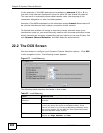
Chapter 21 Load Balancing
NWA-3160 Series User’s Guide
258
21.2.1 Disassociating and Delaying Connections
When your AP becomes overloaded, there are two basic responses it can take. The
first one is to “delay” a client connection. This means that the AP withholds the
connection until the data transfer throughput either is lowered or the client
connection is picked up by another AP.
For example, here the AP has a balanced bandwidth allotment of 6 Mbps. If the
red laptop [R] attempts to connect and it could potentially push the AP over its
allotment, say to 7 Mbps, then the AP delays the red laptop’s connection until it
Dissociate station when
overloaded
Select this to “kick” connections to the AP when it becomes
overloaded. If you leave this unchecked, then the AP simply
delays the connection until it can afford the bandwidth it
requires, or it shunts the connection to another AP within its
broadcast radius.
The kick priority is as follows:
• Idle Timeout - Devices that have been idle the longest will
be kicked first. If none of the connected devices are idle,
then the priority shifts to signal strength.
• Signal Strength - Devices with the weakest signal
strength will be kicked first.
Note: If you enable this function, you should ensure that
there are multiple APs within the broadcast radius
that can accept any rejected or kicked wireless
clients; otherwise, a wireless client attempting to
connect to an overloaded NWA will be kicked
continuously and never be allowed to connect.
Apply Click this to save your changes to the NWA.
Reset Click this to return this screen to its last-saved settings.
Table 82 Load Balancnig
FIELD DESCRIPTION


















